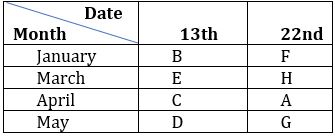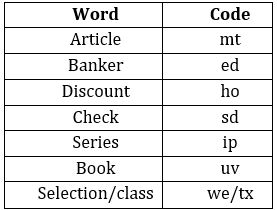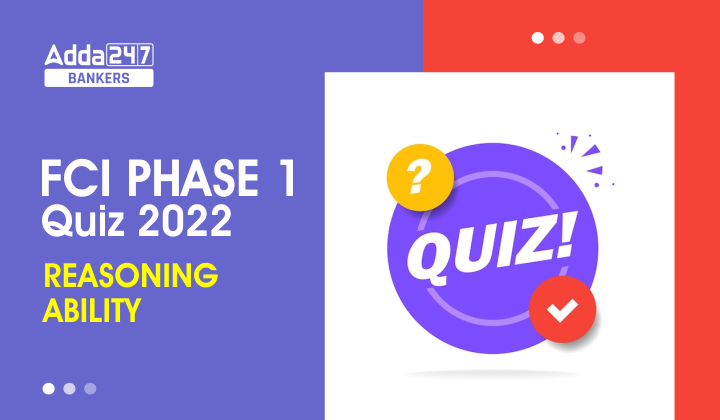Directions (1-5): Study the information carefully and answer the questions given below:
Eight persons A, B, C, D, E, F, G and H are going on holidays in four different months i.e., January, March, April, May on two different dates i.e., 13th and 22nd but not necessary in same order. C goes in the month which has even number of days. Two persons go between C and F. B goes just before F. More than four persons go between B and D. H goes before A and after E. A goes in the month which has even number of days. G does not go on odd number date of the month. G goes after C.
Q1. Who among the following person goes on 13th march?
(a) B
(b) F
(c) E
(d) H
(e) None of these
Q2. How many persons go between F and G?
(a) Four
(b) Three
(c) Two
(d) More than four
(e) None
Q3. Who among the following person goes on 13th January?
(a) C
(b) D
(c) B
(d) A
(e) None of these
Q4. Who among the following person goes just before D?
(a) G
(b) C
(c) A
(d) H
(e) E
Q5. Four of the following five are alike in certain way based from a group, find the one that does not belong to that group?
(a) F
(b) H
(c) A
(d) G
(e) C
Directions (6-10): Study the following information carefully to answer the given questions.
In a certain code language,
“Article discount banker book” is coded as “ho mt uv ed”
“Series check Article” is coded as “ip mt sd”
“Banker check series” is coded as “ip sd ed”
“Check book selection class” is coded as “sd we uv tx”
Q6. What is the code of ‘discount’?
(a) mt
(b) ho
(c) uv
(d) ed
(e) ip
Q7. What is the code of ‘selection’?
(a) sd
(b) we
(c) uv
(d) tx
(e) Can’t be determined
Q8. What may be the code of ‘check life’?
(a) ip bh
(b) sd ny
(c) we bh
(d) ed uv
(e) mt uv
Q9. What is the code of “discount book”?
(a) uv we
(b) mt ed
(c) ho uv
(d) uv ed
(e) None of these
Q10. What is the code of ‘series?
(a) ip
(b) uv
(c) mt
(d) we
(e) tx
Directions (11-15): In each of the questions below are given some statements followed by two conclusions. You have to take the given statements to be true even if they seem to be at variance with commonly known facts. Read all the conclusions and then decide which of the given conclusions logically follows from the given statements disregarding commonly known facts.
(a) If only conclusion I follows.
(b) If only conclusion II follows.
(c) If either conclusion I or II follows.
(d) If neither conclusion I nor II follows.
(e) If both conclusions I and II follow.
Q11. Statements: J>K>L; L<N<A; A=B
Conclusion I: J>A II: B>K
Q12. Statements: P>Q>R≥S<T=U<V
Conclusion I: V≥P II: P>S
Q13. Statements: J>K<L≤M<O=P>Q
Conclusion I: J≥M II: Q>K
Q14. Statements: Z>X=U; U<K<L; L>A
Conclusion I: L>X II: Z≤A
Q15. Statements: Q>R<S; S=T<V; V<N
Conclusion I: Q=N II: N>Q
Solutions
Solutions (1-5):
Sol.

S1. Ans. (c)
S2. Ans. (d)
S3. Ans. (c)
S4. Ans. (c)
S5. Ans. (e)
Solutions (6-10):
Sol.

S6. Ans. (b)
S7. Ans. (e)
S8. Ans. (b)
S9. Ans. (c)
S10. Ans. (a)
S11. Ans. (d)
Sol. I: J>A (False)
II: B>K (False)
S12. Ans. (b)
Sol. I: V≥P (False)
II: P>S (True)
S13. Ans. (d)
Sol. I: J≥M (False)
II: Q>K (False)
S14. Ans. (a)
Sol. I: L>X (True)
II: Z≤A (False)
S15. Ans. (d)
Sol. I: Q=N (False)
II: N>Q (False)





 GA Capsule for SBI Clerk Mains 2025, Dow...
GA Capsule for SBI Clerk Mains 2025, Dow...
 The Hindu Review October 2022: Download ...
The Hindu Review October 2022: Download ...
 ECGC PO Scorecard 2025 Out, Check Marks
ECGC PO Scorecard 2025 Out, Check Marks




